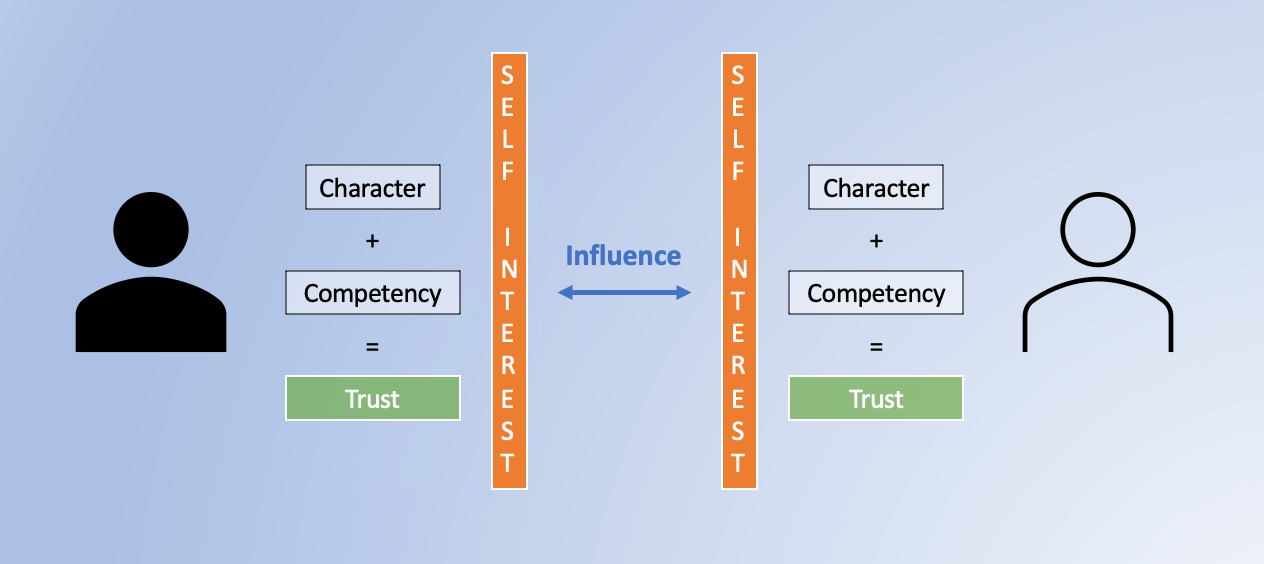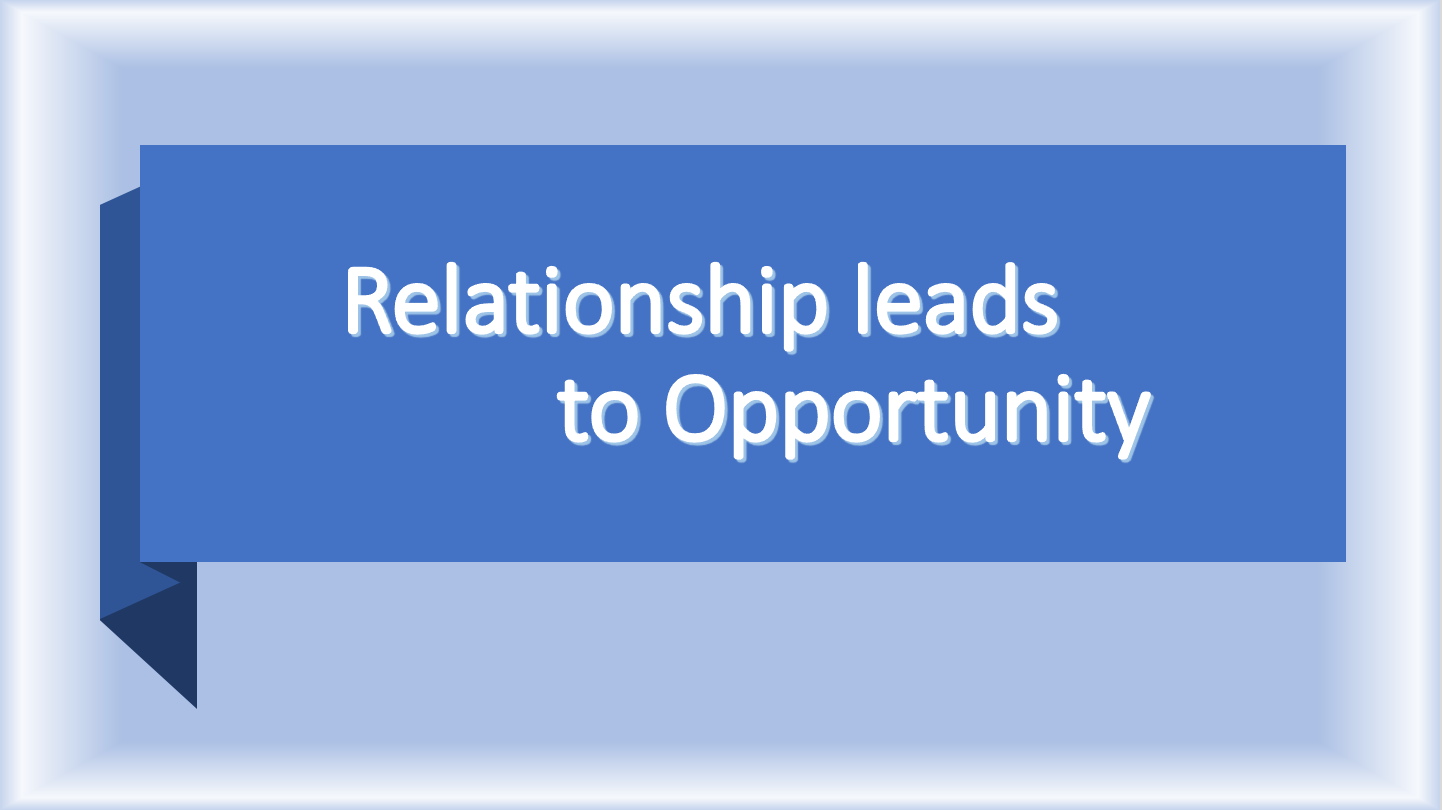Building Trust: Character vs Competency
Let me start by asking you two questions: Have you ever wondered what it takes to influence someone or a group of people? How is it that the best leaders can have a positive impact on a group of people and influence them to achieve a certain task or goal? Answer: effective leadership requires trust.

Let me start by asking you two questions:
- Have you ever wondered what it takes to influence someone or a group of people?
- How is it that the best leaders can have a positive impact on a group of people and influence them to achieve a certain task or goal?
Answer: effective leadership requires trust.
Defining trust
Trust can be broken down into two main components: character and competency (see Figure 1 below). Another way to think about this is chemistry and credibility. If you have chemistry with someone, you form a relationship; this is only one part of the trust equation. You also need to show credibility (competence). Then, the relationship will grow to have trust.

The trust equation holds true when only competency is present. Let's pretend you just met someone new on the job. You are both there probably because your hiring manager found you a good "fit" for their department (i.e. your charming character), but you were more-so hired based on the competence you showed in your interview. Both you and your colleague are aware that your education, degrees, and new position at the workplace are similar. This does not mean that you automatically trust each other. Remember that there are two components of trust. Until you and your new colleague share your character with each other, trust will stay absent from the relationship.
Why is trust important?
People ask two questions when they first meet you (probably not out loud): do I believe in your character, and do you have credible competency to actually benefit the situation?
Notice that both questions address the two components of the trust equation. Each individual in a relationship has to bring character and competency to the table.
A paper prepared by Dr. Luke Chang explains the importance of trust perfectly:
- "Trusting that a partner will honor their agreement is critical for ensuring successful interpersonal, business, and political transaction. Other theorists have additionally emphasized the importance of the trustor’s willingness to be vulnerable (and endure a risk) and the trustee’s ability to overcome self-interested temptations."
In the influence matrix shown in Figure 1, there are barriers to achieving influence on each other even after completing the trust equation. These barriers are hinted at in the excerpt from Dr. Chang: we have a wall of self-interest that we must break down to open ourself to a relationship of influence. The other person also has a wall that has to be brought down. When both walls are lowered, the "influencing" can begin.
There can be immediate influential transactions based on competency or character alone. This occurs when there is a temporary drop in the self-interest barrier between both people. The transaction occurs quickly without developing trust; the barriers of self-interest immediately build back up once the transaction ceases. By taking the time to invest in your relationship, bring character AND competency to the table, and fully lower your self-interest barrier, you can create an influential relationship for life, not simply a one-off transient transaction.
To better conceptualize the barriers and trust equation, think about the following example that I have encountered many times:
- Imagine you are having a conversation with someone about a topic at work or school. You are each showing your competency (let's say you are studying together) and one of you shares something that happened earlier that day in your personal life or maybe a story from your childhood. You share this information freely because you are being vulnerable, taking a risk, and trying to break down the barriers and build trust. If the other person hardly acknowledges or does not acknowledge your story at all, your barrier of character will bounce right back up and trusting the other person will be extremely difficult. On the other hand, if the other person acknowledges and replies to it, trust is built.
Trust in the workplace
We can use the influence matrix to help us think about where growth is needed to build relationships. In pharmacy, we often hear how small the "pharmacy world" is and that we should always be building our network. This network of relationships can lead to opportunity.

There are countless stories about pharmacists ending up in their current position due to "someone in their network." Whether a co-worker or the hiring manager themself, that pharmacist had a relationship that turned into an opportunity. This is important because this pharmacist has a level of trust (from their relationship) even before the first day. This will make it easier to follow their manager or boss in the future.
Think about it: when was the last time you followed a leader blindly without knowing at least a little something about their character or competency? One of the most important aspects of building a strong department or team is building that culture and trust through chemistry and credibility.
Dr. Paul J. Zak (a professor of economics, psychology and management at Claremont Graduate University, a regular TED speaker, and author) says trust is a necessary building block of a culture trying to make a meaningful difference. "Employees in high-trust organizations are more productive, have more energy at work, collaborate better with their colleagues, and stay with their employers longer than people working at low-trust companies. They also suffer less chronic stress and are happier with their lives, and these factors fuel stronger performance."
Does this not sound like an ideal workplace? A workplace culture with trust! I think a change in pace is well warranted, especially with our current standard of "burnout culture."
To make the change toward adding trust into our workplaces, it often starts with the leaders of the department. Dr. Zak shared survey data that reported over half of Chief Executive Officers (CEOs) think a lack of trust is a threat to their organization growth. The next step, in my eyes, would be to start building trust in their workplace. However, many CEOs do not know where to start. Even if the CEO or personal manager is unsure where to start, you and I can start to develop trust on our own level to get the ball rolling.
The science of trust
As members of the medical field, we are obsessed with the pathophysiology of diseases and mechanisms of medications. Therefore, some of you may be wondering about the science behind trust. What determines how humans interact socially? Why do we cooperate with some but not others? Social scientists have used the "game theory" to try to answer these questions. Game theory is also used by other disciplines such as economics, psychology, sociology, and political science.

Game theory dates back to the 1920s and consists of three elements: the players, a set of available actions for each player, and a so-called pay-off function for each player. The key feature is that each player makes individual decisions according to his or her own interests, and the behavior of all players determines the final outcome. The outcomes then, for each individual player, are not dependent on just their own behaviors, but also of the player that they interact with.
Below is an example of game theory called "the trust game" that many authors describe in their teachings, including Dr. Zak.
The trust game rules/overview:
- Player 1 is the investor.
- Player 2 is the trustee.
- Both players are given $10. Player 1 can then decide to either A) keep the $10 or B) transfer up to $10 to Player 2 where it will triple to a max value of $30.
- Player 1 has to decide whether to take a risk and trust Player 2. The risk of transferring money to Player 2 is that Player 2 may decide to keep all of the money. If Player 1 transfers all $10 to Player 2, now Player 2 has $40 and Player 1 has $0. After receiving money, Player 2 can transfer up to $40 back to Player 1 (and the money value stays this same on the transfer) or keep it all for themself.
- The best case scenario is that both Players trust each other and they each walk away with $20. If one of the Player's does not trust the other, then the value of the money will differ between each upon completion of the game. If neither Player trusts each other, both will walk away with their starting amount of $10.
The trust game explanation as explained by Michael Kosfeld:
- "The investor's decision in this game can be interpreted as a decision of trust—hence the name of the game. The investor must trust that the trustee will return a sufficiently large amount—at least as large as the original transfer—for the game to be profitable. At the same time, the trustee's behavior can be seen as a measure of trustworthiness: the larger the trustee's back-transfer, the higher his or her trustworthiness towards the investor. Each player could act to maximize his or her own individual monetary income, however, the trustee has no reason to return any positive amount. The interaction ends after the trustee's decision, which means that the investor has no opportunity to sanction the trustee for misbehavior. The game's equilibrium prediction is therefore that the trustee returns 0 points to the investor, regardless of the transfer received, and that the investor does not transfer any positive amount but retains all of his or her endowment. Although this is an equilibrium, the resulting outcome is clearly inefficient as no gains are realized: both players earn $10 points, but they could have earned twice as much if only the investor had trusted and the trustee had behaved in a trustworthy manner."
Where science fits in:
To "predict" how the game would play out, the original focus of many researchers was on social, environmental, and institutional determinants of human behavior. Neuroscientists, however, avoided explicitly modeling these types of human social interactions in the past. In more recent research, a combination of social and neuroscience has been used to best understand determinants of human interactions.
There are theories that oxytocin might increase the willingness of humans to show trust towards others. Oxytocin is a neuropeptide that is produced in the hypothalamus and stored in the posterior pituitary. When released into the CNS, oxytocin is known to promote social behavior (as well as many other things). This includes bonding, maternal behavior, sexual behavior, and trust.
There is literature in humans to suggest that oxytocin reduces anxiety and the neuroendocrine responsiveness to social stressors. One particular study evaluated intranasal oxytocin compared to placebo while the test individuals played the trust game. The results showed oxytocin increased the subject's willingness to trust their trustee, but did not make them more optimistic about the trustee's trustworthiness as the amount of money transferred back to the investor did not differ between oxytocin and placebo.
Dr. Zak explains the results of this study a little further: "comparing participants who received a real dose with those who received a placebo, we found that giving people 24 units of synthetic oxytocin more than doubled the amount of money they sent to a stranger. Using a variety of psychological tests, we showed that those receiving oxytocin remained cognitively intact. We also found that they did not take excessive risks in a gambling task, so the increase in trust was not due to neural disinhibition. Oxytocin appeared to do just one thing—reduce the fear of trusting a stranger."

Putting it all together
So what is the purpose of explaining the proposed chemical neurotransmitter behind trust and influence? There is not anything you and I can do in our day-to-day lives to produce more or less oxytocin on command. The information is more food-for-thought for the next time you go into a new relationship or workplace. You can reflect on a time when you let your barriers down to trust someone else and felt good about it. You now know that oxytocin is most likely at work in your brain. I think that is pretty neat.
Final thoughts on trust and influence
The whole influence matrix is something I have seen by changing workplaces and networks often. Up until understanding the trust equation, I did not know what I seemed to be lacking in developing new relationships. I always showed my competency, and the other individual would show their competency, but I never noticed the lack of character on my end over the years. I lacked the simple gesture of walking into the workplace in the morning and saying "Hi, how was your weekend?" This question was something that did not interest me. I used to walk into work solely for patient care, not social collaboration.
Another example to share my lack of character comes from calling up a colleague for help on a patient case. I would immediately jump to the problem out of "respect" for the other person's time. Over the years, I observed more and more of my colleagues taking a second to first chat about topics like personal well-being, what is new with the kids, or how their favorite hobby is going.
I began to correlate this lack of character motive from me with my friendships in the main pharmacy and inside and outside the workplace: hardly existent.
I have also noticed over the years various leaders that I have enjoyed working for and leaders that I have not. With reflection about the trust matrix over the years, I noticed the leaders who lead a good team were present in the main pharmacy, did not hide in their office, asked us how our personal lives were, and did not simply expect us to meet objective quotas and data points. These types of leaders are the ones I truly enjoyed working for in the past. This is because the relationship between the worker and the leader started from competency. Over time, the leader reached out to break down the barrier with character. Trust was able to be built over the first few months working together, and now spans for a lifetime, even if we both have moved on to bigger and better things.
Have thoughts of your own on this topic? Share then in the comment section below!
*The influence matrix figure and concept is derived by the author from various sources, papers, concepts, and research. Living Zoom example, Sketch Bubble example, MKM Design example, as well as the other references throughout this article.

